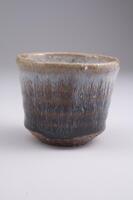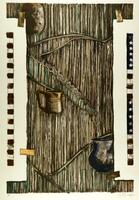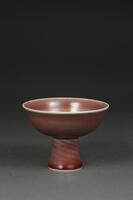46 UMMA Objects
46 UMMA Objects
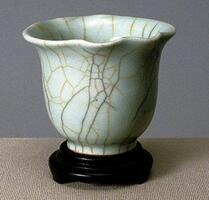
Chinese (Chinese (culture or style))
Guan ware type cup with flaring, undulating rim
1700 – 1899
Gift of Mr. F. Karel Wiest
1982/2.3
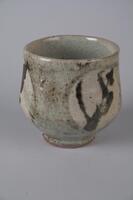
Old Mashiko Ware
Mashiko Ware Teacup (style of Hamada Shôji)
1950 – 1960
Gift of Mr. and Mrs. Stephen H. Spurr
2003/2.18
![<p>The cup has a mouth that curves slightly inwards; this is a form typical of round cups with saucers produced in large numbers in the 13th and 14th centuries. The cup is decorated only on the outer rim with a fret-patterned band. Repaired damage is visible on several parts on the mouth, as well as cracking that occurred during ring. Glaze has been applied down to the foot, and three quartzite spur marks remain on the outer base. The partially oxidized body displays darker patches on the surface, but it preserves a bright celadon color overall.<br />
[<em>Korean Collection, University of Michigan Museum of Art </em>(2014) p.120]</p>
The celadon cup has a mildly inverted rim with curved sides that are bent once, at a sharp angle, near the base. The surface is coated with a greenish blue glaze. The slightly inward-turning mouth facilitates drinking while the sides curve gently toward the base. <p>The cup has a mouth that curves slightly inwards; this is a form typical of round cups with saucers produced in large numbers in the 13th and 14th centuries. The cup is decorated only on the outer rim with a fret-patterned band. Repaired damage is visible on several parts on the mouth, as well as cracking that occurred during ring. Glaze has been applied down to the foot, and three quartzite spur marks remain on the outer base. The partially oxidized body displays darker patches on the surface, but it preserves a bright celadon color overall.<br />
[<em>Korean Collection, University of Michigan Museum of Art </em>(2014) p.120]</p>
The celadon cup has a mildly inverted rim with curved sides that are bent once, at a sharp angle, near the base. The surface is coated with a greenish blue glaze. The slightly inward-turning mouth facilitates drinking while the sides curve gently toward the base.](/media/W1siZiIsIjIwMjIvMDkvMjQvMmRjZTRvbXNlel9kZWZhdWx0LmpwZyJdLFsicCIsInRodW1iIiwiMjQweDIwMCJdXQ?sha=b6f3e998b597b135)
Korean (Korean (culture or style))
Wine cup with incised patterns
1100 – 1299
Gift of Bruce and Inta Hasenkamp and Museum purchase made possible by Elder and Mrs. Sang-Yong Nam
2004/1.225
![<p>The wide mouth of this cup gives it a form similar to that of a bowl. The foot has its glaze removed and has three refractory spur marks. Fine crackles are spread throughout the inner wall. The glaze is well fused, produing a shiny surface.<br />
[<em>Korean Collection, University of Michigan Museum of Art </em>(2014) p.121]<br />
</p>
<p>The wide mouth of this cup gives it a form similar to that of a bowl. The foot has its glaze removed and has three refractory spur marks. Fine crackles are spread throughout the inner wall. The glaze is well fused, produing a shiny surface.<br />
[<em>Korean Collection, University of Michigan Museum of Art </em>(2014) p.121]<br />
</p>](/media/W1siZiIsIjIwMjIvMDkvMjQvOTExZzNndjdwaF9kZWZhdWx0LmpwZyJdLFsicCIsInRodW1iIiwiMjQweDIwMCJdXQ?sha=4812735bad0e44fb)
Korean (Korean (culture or style))
Wine Cup
13th century
Gift of Bruce and Inta Hasenkamp and Museum purchase made possible by Elder and Mrs. Sang-Yong Nam
2004/1.256

Chinese (Chinese (culture or style))
Cup
1368 – 1644
Gift of Toshiko Ogita in memory of Tomoo Ogita
1987/1.297
![Dark gray high-fired stoneware cup. The base is tinged dark green and a natural glaze has formed on the outer surface, and on some of the inner surface. Two horizontal ridges encircle the body, and the edge rim is sharp.<br />
<br />
This is a dark gray, high-fired stoneware cup. The base is tinged dark green. Natural glaze has formed on the entire outer surface and parts of the inner surface. The edge of the rim is sharp. Two horizontal ridges encircle the body. The base of the cup is flat and rounded where it joins the body. The wall is thicker at the base than at the rim or the central body.
<p>[Korean Collection, University of Michigan Museum of Art (2017) p. 72]</p>
Dark gray high-fired stoneware cup. The base is tinged dark green and a natural glaze has formed on the outer surface, and on some of the inner surface. Two horizontal ridges encircle the body, and the edge rim is sharp.<br />
<br />
This is a dark gray, high-fired stoneware cup. The base is tinged dark green. Natural glaze has formed on the entire outer surface and parts of the inner surface. The edge of the rim is sharp. Two horizontal ridges encircle the body. The base of the cup is flat and rounded where it joins the body. The wall is thicker at the base than at the rim or the central body.
<p>[Korean Collection, University of Michigan Museum of Art (2017) p. 72]</p>](/media/W1siZiIsIjIwMjIvMDkvMjQvNTMxa2k0bmppNl9kZWZhdWx0LmpwZyJdLFsicCIsInRodW1iIiwiMjQweDIwMCJdXQ?sha=a1fc04cb9cf817cf)
Korean (Korean (culture or style))
Cup
400 – 599
Gift and partial purchase from Bruce and Inta Hasenkamp, purchase with funds from Elder and Mrs Sang-Yong Nam
2021/1.142

Kawai Kanjirô
Tea bowl with handpainted floral design
1924 – 1934
Gift of Mr. and Mrs. Stephen H. Spurr
2003/2.13
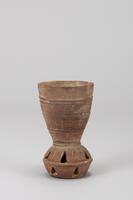
Korean (Korean (culture or style))
Bell Cup (goblet with rattle base)
5th century
Gift of Bruce and Inta Hasenkamp and Museum purchase made possible by Elder and Mrs. Sang-Yong Nam
2004/1.170
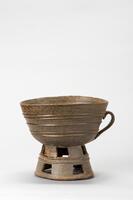
Korean (Korean (culture or style))
Pedestal Cup or bowl with handle, on cut-out pedestal foot
5th century
Gift of Bruce and Inta Hasenkamp and Museum purchase made possible by Elder and Mrs. Sang-Yong Nam
2004/1.180
Loading…
